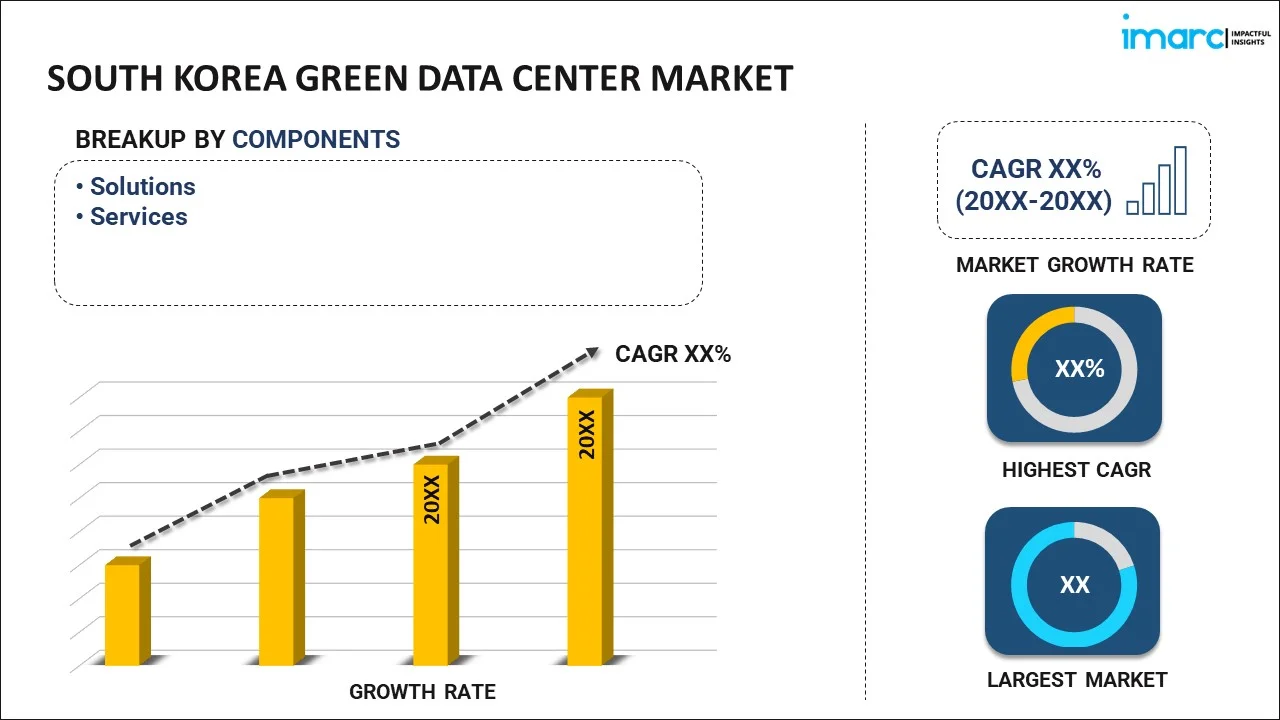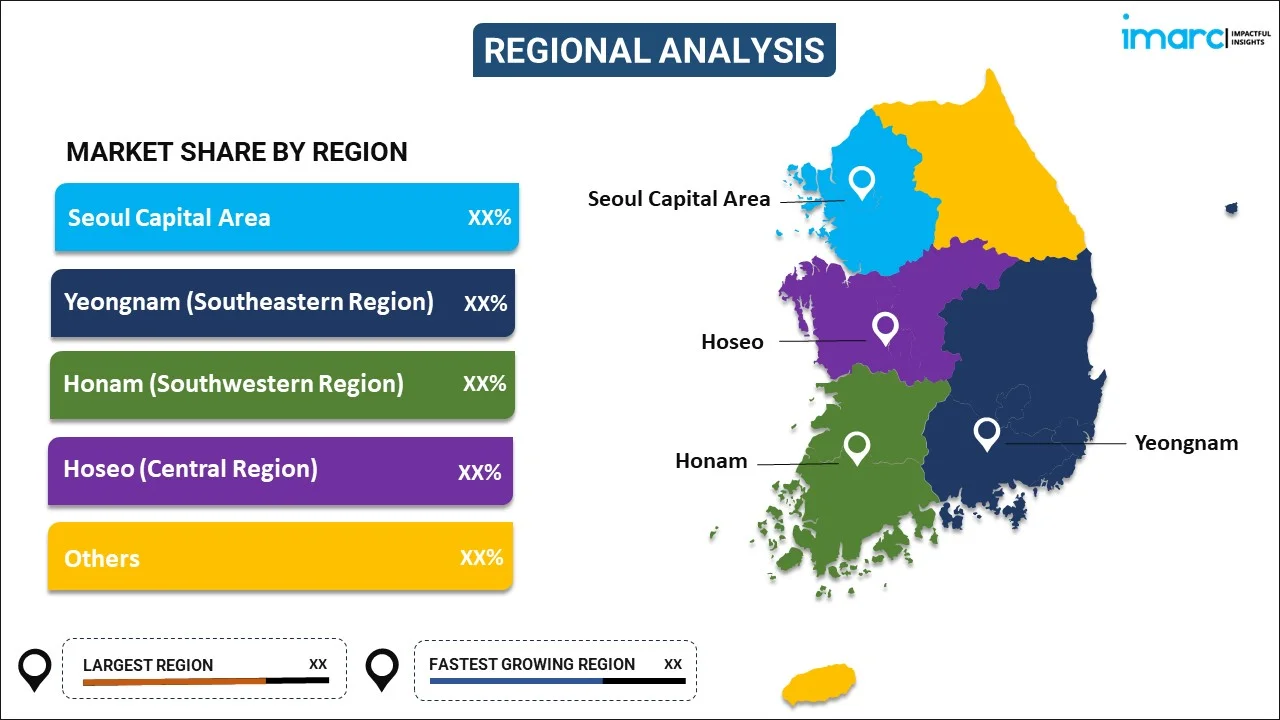
South Korea Green Data Center Market Report by Component (Solutions, Services), Data Center Type (Colocation Data Centers, Managed Service Data Centers, Cloud Service Data Centers, Enterprise Data Centers), Industry Vertical (Healthcare, BFSI, Government, Telecom and IT, and Others), and Region 2025-2033
Market Overview:
The South Korea green data center market size is projected to exhibit a growth rate (CAGR) of 11.59% during 2025-2033. The stringent environmental regulations and global initiatives promoting sustainability, the escalating costs of traditional energy sources, the increasing awareness of climate change and the role of technology in environmental degradation, and the rapid advancements in renewable energy technologies are some of the factors propelling the market.
|
Report Attribute
|
Key Statistics
|
|---|---|
|
Base Year
|
2024 |
|
Forecast Years
|
2025-2033
|
|
Historical Years
|
2019-2024
|
| Market Growth Rate (2025-2033) | 11.59% |
A green data center is a facility designed to minimize its environmental impact and enhance energy efficiency in the management and operation of information technology infrastructure. Unlike traditional data centers that often consume significant amounts of energy and resources, these centers prioritize sustainability, resource conservation, and reduced carbon emissions. These facilities incorporate a range of innovative technologies and practices to achieve these environmental goals. Key features of a green data center include energy-efficient IT equipment, such as servers, storage, and networking devices, designed to optimize performance per watt. Cooling systems are engineered for efficiency, utilizing advanced methods like liquid cooling, free cooling, and intelligent temperature management to minimize energy consumption associated with climate control. Renewable energy sources play a crucial role in green data centers. Facilities often integrate solar, wind, or other renewable power options to reduce reliance on conventional energy grids powered by non-renewable resources. Additionally, energy-efficient lighting, advanced power distribution systems, and efficient backup power solutions contribute to the overall sustainability of these facilities. Green data centers emphasize recycling and responsible waste management. They minimize electronic waste by refurbishing or repurposing outdated equipment and adopting circular economy principles. The concept of a green data center is rooted in a holistic approach to environmental stewardship within the information technology sector. It reflects a commitment to minimizing the ecological footprint of data center operations, promoting energy efficiency, and advancing sustainable practices throughout the lifecycle of IT infrastructure. As the demand for responsible business practices and environmental consciousness grows, green data centers continue to gain prominence as essential components of a more sustainable and eco-friendly digital infrastructure.
South Korea Green Data Center Market Trends:
The market in South Korea is majorly driven by the increasing recognition of the ecological impact of traditional data centers. As environmental awareness grows, businesses and organizations are proactively seeking greener alternatives to mitigate their carbon footprint. Green data centers, designed to optimize resource use and minimize environmental impact, offer a compelling solution in line with this sustainability imperative. Furthermore, the escalating energy costs and the need for operational efficiency represent another significant factor driving market growth. These data centers prioritize energy efficiency through innovative technologies, such as advanced cooling systems, server virtualization, and power management solutions. This not only addresses the rising costs associated with energy consumption but also aligns with the broader industry trend toward optimizing operational efficiency. Moreover, government regulations and initiatives promoting environmental sustainability are catalyzing the market. Several regions are implementing stringent regulations and offering incentives to encourage businesses to adopt greener practices. Compliance with these regulations and participation in sustainability programs become driving factors for organizations looking to establish or upgrade their data center infrastructure. Besides, the rise of corporate social responsibility (CSR) and the emphasis on sustainable business practices play a crucial role in market expansion. Companies are increasingly recognizing the importance of integrating environmental responsibility into their operations as part of their CSR initiatives. Adopting green data center practices becomes a tangible and impactful way for organizations to showcase their commitment to sustainability, positively impacting brand image and stakeholder relationships. Additionally, advancements in technology, particularly in the realm of renewable energy, contribute to the market expansion. The availability and affordability of renewable energy sources, such as solar and wind power, provide viable alternatives to traditional energy grids. These centers leverage these technologies to reduce reliance on non-renewable resources, aligning with the global push toward a more sustainable and eco-friendly energy landscape. This, in turn, is creating a positive outlook for the market.
South Korea Green Data Center Market Segmentation:
IMARC Group provides an analysis of the key trends in each segment of the market, along with forecasts at the country level for 2025-2033. Our report has categorized the market based on component, data center type, and industry vertical.
Component Insights:

- Solutions
- Power Systems
- Servers
- Monitoring and Management Systems
- Networking Systems
- Cooling Systems
- Others
- Services
- System Integration Services
- Maintenance and Support Services
- Training and Consulting Services
The report has provided a detailed breakup and analysis of the market based on the component. This includes solutions (power systems, servers, monitoring and management systems, networking systems, cooling systems, and others) and services (system integration services, maintenance and support services, and training and consulting services).
Data Center Type Insights:
- Colocation Data Centers
- Managed Service Data Centers
- Cloud Service Data Centers
- Enterprise Data Centers
A detailed breakup and analysis of the market based on the data center type have also been provided in the report. This includes colocation data centers, managed service data centers, cloud service data centers, and enterprise data centers.
Industry Vertical Insights:
- Healthcare
- BFSI
- Government
- Telecom and IT
- Others
The report has provided a detailed breakup and analysis of the market based on the industry vertical. This includes healthcare, BFSI, government, telecom and IT, and others.
Regional Insights:

- Seoul Capital Area
- Yeongam (Southeastern Region)
- Honam (Southwestern Region)
- Hoseo (Central Region)
- Others
The report has also provided a comprehensive analysis of all the major regional markets, which include Seoul Capital Area, Yeongam (Southeastern Region), Honam (Southwestern Region), Hoseo (Central Region), and Others.
Competitive Landscape:
The market research report has also provided a comprehensive analysis of the competitive landscape in the market. Competitive analysis such as market structure, key player positioning, top winning strategies, competitive dashboard, and company evaluation quadrant has been covered in the report. Also, detailed profiles of all major companies have been provided.
South Korea Green Data Center Market Report Coverage:
| Report Features | Details |
|---|---|
| Base Year of the Analysis | 2024 |
| Historical Period | 2019-2024 |
| Forecast Period | 2025-2033 |
| Units | Million USD |
| Scope of the Report | Exploration of Historical and Forecast Trends, Industry Catalysts and Challenges, Segment-Wise Historical and Predictive Market Assessment:
|
| Components Covered |
|
| Data Center Types Covered | Colocation Data Centers, Managed Service Data Centers, Cloud Service Data Centers, Enterprise Data Centers |
| Industry Verticals Covered | Healthcare, BFSI, Government, Telecom and IT, Others |
| Regions Covered | Seoul Capital Area, Yeongnam (Southeastern Region), Honam (Southwestern Region), Hoseo (Central Region), Others |
| Customization Scope | 10% Free Customization |
| Post-Sale Analyst Support | 10-12 Weeks |
| Delivery Format | PDF and Excel through Email (We can also provide the editable version of the report in PPT/Word format on special request) |
Key Questions Answered in This Report:
- How has the South Korea green data center market performed so far and how will it perform in the coming years?
- What has been the impact of COVID-19 on the South Korea green data center market?
- What is the breakup of the South Korea green data center market on the basis of component?
- What is the breakup of the South Korea green data center market on the basis of data center type?
- What is the breakup of the South Korea green data center market on the basis of industry vertical?
- What are the various stages in the value chain of the South Korea green data center market?
- What are the key driving factors and challenges in the South Korea green data center?
- What is the structure of the South Korea green data center market and who are the key players?
- What is the degree of competition in the South Korea green data center market?
Key Benefits for Stakeholders:
- IMARC’s industry report offers a comprehensive quantitative analysis of various market segments, historical and current market trends, market forecasts, and dynamics of the South Korea green data center market from 2019-2033.
- The research report provides the latest information on the market drivers, challenges, and opportunities in the South Korea green data center market.
- Porter's five forces analysis assist stakeholders in assessing the impact of new entrants, competitive rivalry, supplier power, buyer power, and the threat of substitution. It helps stakeholders to analyze the level of competition within the South Korea green data center industry and its attractiveness.
- A competitive landscape allows stakeholders to understand their competitive environment and provides an insight into the current positions of key players in the market.
Need more help?
- Speak to our experienced analysts for insights on the current market scenarios.
- Include additional segments and countries to customize the report as per your requirement.
- Gain an unparalleled competitive advantage in your domain by understanding how to utilize the report and positively impacting your operations and revenue.
- For further assistance, please connect with our analysts.
 Request Customization
Request Customization
 Speak to an Analyst
Speak to an Analyst
 Request Brochure
Request Brochure
 Inquire Before Buying
Inquire Before Buying




.webp)




.webp)












